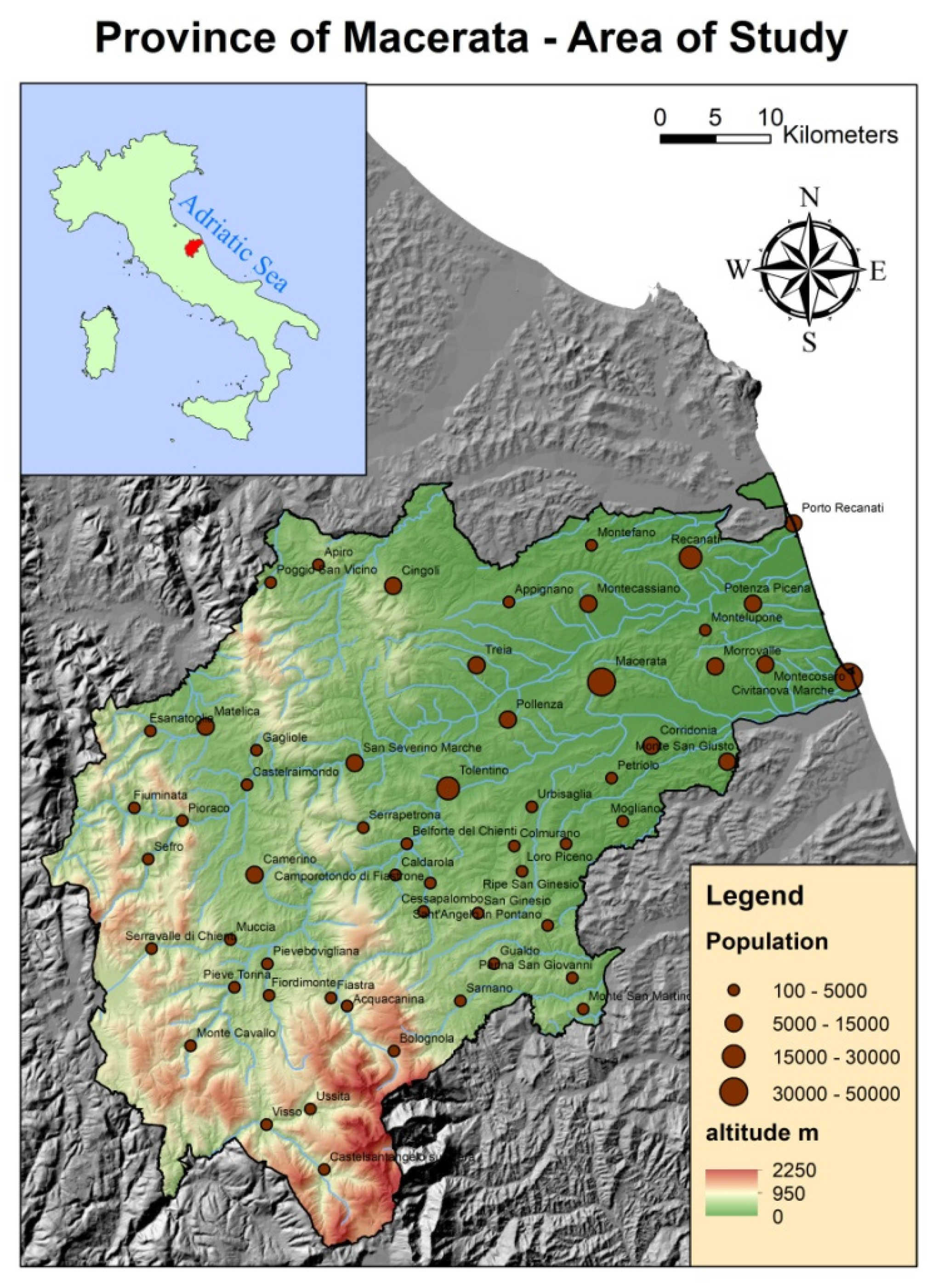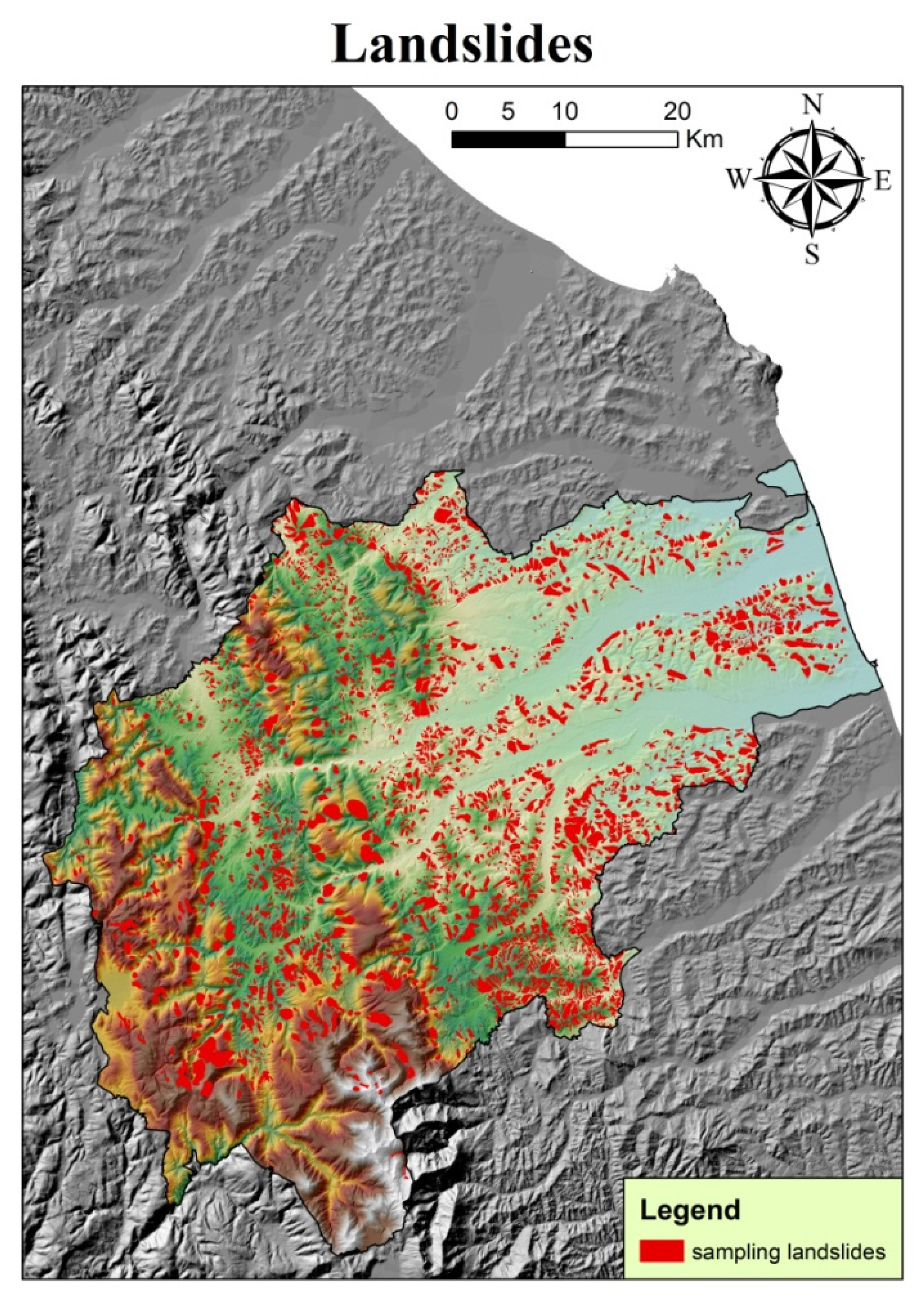Statistical Analysis of Landslide Susceptibility, Macerata Province (Central Italy)
Abstract
:1. Introduction
1.1. State of the Art
1.2. Study Area
2. Materials and Methods
2.1. Data Sampling and Preparation
2.2. Model Building
3. Results
4. Discussion
5. Conclusions
Author Contributions
Funding
Institutional Review Board Statement
Informed Consent Statement
Data Availability Statement
Conflicts of Interest
References
- Trigila, A.; Iadanza, C.; Bussettini, M.; Lastoria, B. Dissesto Idrogeologico in Italia: Pericolosità e Indicatori di Rischio—Edizione; Rapporti 287/2018; ISPRAL: Rome, Italy, 2018. [Google Scholar]
- Gariano, S.L.; Guzzetti, F. Evaluating the Impact of Climate Change on Landslide Occurrence, Hazard, and Risk: From Global to Regional Scale. In Proceedings of the 19th EGU General Assembly Conference Abstracts, Austria, Vienna, 23–28 April 2017; Volume 19, p. 503. [Google Scholar]
- Winter, M.G.; Shearer, B. Climate change and landslide hazard and risk in Scotland. Eng. Geol. Soc. Territ. 2015, 1, 411–414. [Google Scholar]
- Crowley, T.J.; Berner, R.A. CO2 and climate change. Science 2001, 292, 870–872. [Google Scholar] [CrossRef] [PubMed]
- Falcinelli, S. Fuel production from waste CO2 using renewable energies. Catal Today 2020, 348, 95–101. [Google Scholar] [CrossRef]
- Ciabatta, L.; Camici, S.; Brocca, L.; Ponziani, F.; Stelluti, M.; Berni, N.; Moramarco, T. Assessing the impact of climate-change scenarios on landslide occurrence in Umbria Region, Italy. J. Hydrol. 2016, 541, 285–295. [Google Scholar] [CrossRef]
- Gariano, S.L.; Petrucci, O.; Rianna, G.; Santini, M.; Guzzetti, F. Impacts of past and future land changes on landslides in southern Italy. REG Environ. Chang. 2018, 18, 437–449. [Google Scholar] [CrossRef]
- Tasser, E.; Mader, M.; Tappeiner, U. Effects of land use in alpine grasslands on the probability of landslides. Basic Appl. Ecol. 2003, 4, 271–280. [Google Scholar] [CrossRef]
- Chowdhury, R.; Flentje, P. Role of slope reliability analysis in landslide risk management. B Eng. Geol. Environ. 2003, 62, 41–46. [Google Scholar] [CrossRef]
- Pachauri, A.K.; Pant, M. Landslide hazard mapping based on geological attributes. Eng. Geol. 1992, 32, 81–100. [Google Scholar] [CrossRef]
- Yin, Y.; Wang, F.; Sun, P. Landslide hazards triggered by the 2008 Wenchuan earthquake, Sichuan, China. Landslides 2009, 6, 139–152. [Google Scholar] [CrossRef]
- Yilmaz, I. Landslide susceptibility mapping using frequency ratio, logistic regression, artificial neural networks and their comparison: A case study from Kat landslides (Tokat—Turkey). Comput. Geosci. 2009, 35, 1125–1138. [Google Scholar] [CrossRef]
- Lee, S.; Min, K. Statistical analysis of landslide susceptibility at Yongin, Korea. Environ. Geol. 2001, 40, 1095–1113. [Google Scholar] [CrossRef]
- Pourghasemi, H.R.; Pradhan, B.; Gokceoglu, C.; Mohammadi, M.; Moradi, H.R. Application of weights-of-evidence and certainty factor models and their comparison in landslide susceptibility mapping at Haraz watershed, Iran. ARAB J. Geosci. 2013, 6, 2351–2365. [Google Scholar] [CrossRef]
- Vakhshoori, V.; Zare, M. Landslide susceptibility mapping by comparing weight of evidence, fuzzy logic, and frequency ratio methods. Geomat. Nat. Hazards Risk 2016, 7, 1731–1752. [Google Scholar] [CrossRef]
- Bonham-Carter, G.F. Integration of Geoscientific Data Using GIS. In Geographic Information Systems: Principles and Applications: Longman; Maguire, D.J., Goodchild, M.F., Rhind, D.W., Eds.; Longdom: Brussels, Belgium, 1991; Volume 2, pp. 171–184. [Google Scholar]
- Agterberg, F.P.; Bonham-Carter, G.F.; Cheng, Q.; Wright, D.F. Weights of Evidence Modeling and Weighted Logistic Regression in Mineral Potential Mapping. In Computers in Geology; Davis, J.C., Herzfeld, U.C., Eds.; Oxford University Press: New York, NY, USA, 1993; pp. 13–32. [Google Scholar]
- Regmi, N.R.; Giardino, J.R.; Vitek, J.D. Modeling susceptibility to landslides using the weight of evidence approach: Western Colorado, USA. Geomorphology 2010, 115, 172–187. [Google Scholar] [CrossRef]
- Kayastha, P.; Dhital, M.R.; De Smedt, F. Landslide susceptibility mapping using the weight of evidence method in the Tinau watershed, Nepal. Nat. Hazards 2012, 63, 479–498. [Google Scholar] [CrossRef]
- Barbieri, G.; Cambuli, P. The Weight of Evidence Statistical Method in Landslide Susceptibility Mapping of the Rio Pardu Valley (Sardinia, Italy). In Proceedings of the 18th World IMACS Congress and MODSIM09 International Congress on Modelling and Simulation: Interfacing Modelling and Simulation with Mathematical and Computational Sciences, Cairns, Australia, 13–17 July 2009; pp. 2658–2664. [Google Scholar]
- Piacentini, D.; Troiani, F.; Soldati, M.; Notarnicola, C.; Savelli, D.; Schneiderbauer, S.; Strada, C. Statistical analysis for assessing shallow-landslide susceptibility in South Tyrol (south-eastern Alps, Italy). Geomorphology 2012, 151, 196–206. [Google Scholar] [CrossRef]
- Cervi, F.; Berti, M.; Borgatti, L.; Ronchetti, F.; Manenti, F.; Corsini, A. Comparing predictive capability of statistical and deterministic methods for landslide susceptibility mapping: A case study in the northern Apennines (Reggio Emilia Province, Italy). Landslides 2010, 7, 433–444. [Google Scholar] [CrossRef]
- Gentilucci, M.; Barbieri, M.; Burt, P. Climatic Variations in Macerata Province (Central Italy). Water Sui 2018, 10, 1104. [Google Scholar] [CrossRef] [Green Version]
- Gentilucci, M.; Bisci, C.; Burt, P.; Fazzini, M.; Vaccaro, C. Interpolation of Rainfall through Polynomial Regression in the Marche Region (Central Italy). In The Annual International Conference on Geographic Information Science; Springer: Cham, Switzerland, 2018; pp. 55–73. [Google Scholar]
- Gentilucci, M.; Materazzi, M.; Pambianchi, G.; Burt, P.; Guerriero, G. Assessment of Variations in the Temperature-Rainfall Trend in the Province of Macerata (Central Italy), Comparing the Last Three Climatological Standard Normals (1961–1990; 1971–2000; 1981–2010) for Biosustainability Studies. Environ. Process. 2019, 6, 1–22. [Google Scholar] [CrossRef]
- Gentilucci, M.; Barbieri, M.; Lee, H.S.; Zardi, D. Analysis of Rainfall Trends and Extreme Precipitation in the Middle Adriatic Side, Marche Region (Central Italy). Water 2019, 11, 1948. [Google Scholar] [CrossRef] [Green Version]
- Beniston, M.; Stephenson, D.B.; Christensen, O.B.; Ferro, C.A.; Frei, C.; Goyette, S.; Halsnaes, K.; Holt, T.; Jylhä, K.; Koffi, B.; et al. Future extreme events in European climate: An exploration of regional climate model projections. Clim. Chang. 2007, 81, 71–95. [Google Scholar] [CrossRef] [Green Version]
- Gentilucci, M.; Barbieri, M.; Burt, P. Climate and Territorial Suitability for the Vineyards Developed Using GIS Techniques. In Exploring the Nexus of Geoecology, Geography, Geoarcheology and Geotourism: Advances and Applications for Sustainable Development in Environmental Sciences and Agroforestry Research; Springer: Cham, Switzerland, 2019; pp. 11–13. [Google Scholar]
- Dramis, F.; Farabollini, P.; Gentili, B.; Pambianchi, G. Neotectonics and Large-Scale Gravitational Phenomena in the Umbria–Marche Apennines, Italy. In Proceedings of the Seismically Induced Ground Ruptures and Large Scale Mass Movements. Field Excursion and Meeting, Apennines, Italy, 21–27 September 2001; Volume 4, pp. 17–30. [Google Scholar]
- Kweon, I.S.; Kanade, T. Extracting topographic terrain features from elevation maps. Cvgip Image Underst. 1994, 59, 171–182. [Google Scholar] [CrossRef]
- Ninyerola, M.; Pons, X.; Roure, J.M. A methodological approach of climatological modelling of air temperature and precipitation through gis techniques. Int. J. Clim. 2000, 20, 1823–1841. [Google Scholar] [CrossRef]
- Qin, Q.; Wang, H.; Lei, X.; Li, X.; Xie, Y.; Zheng, Y. Spatial variability in the amount of forest litter at the local scale in northeastern China: Kriging and cokriging approaches to interpolation. Ecol. Evol. 2020, 10, 778–790. [Google Scholar] [CrossRef] [Green Version]
- Gentilucci, M.; Barbieri, M.; Burt, P.; D’Aprile, F. Preliminary data validation and reconstruction of temperature and precipitation in Central Italy. Geosciences 2018, 8, 202. [Google Scholar] [CrossRef] [Green Version]
- Gilleland, E.; Katz, R.W. extRemes 2.0: An extreme value analysis package in R. J. Stat. Softw. 2016, 72, 1–39. [Google Scholar] [CrossRef] [Green Version]
- Sumaryono, D.M.; Sulaksana, N.; DasaTriana, Y. Weights of Evidence Method for Landslide Susceptibility Mapping in Tandikek and Damar Bancah, West Sumatra, Indonesia. Int. J. Sci. Res. (IJSR) 2015, 4, 1283–1290. [Google Scholar]
- Mattioli, M.; Pieruccini, P.; Pennacchioni, E.; Piergiovanni, A.; Sandroni, P.; Tosti, S.; Tramontana, M. PROGETTO CARG, Note Illustrative Della Carta Geologica d’Italia 1:50.000. 2002. Available online: https://www.facebook.com/PaginaUfficialeRegioneMarche/ (accessed on 1 November 2020).
- Macfarlane, D.F. Observations and predictions of the behaviour of large, slow-moving landslides in schist, Clyde Dam reservoir, New Zealand. Eng. Geol. 2009, 109, 5–15. [Google Scholar] [CrossRef]
- Ferlisi, S.; Peduto, D.; Gullà, G.; Nicodemo, G.; Borrelli, L.; Fornaro, G. The Use of DInSAR Data for the Analysis of Building Damage Induced by Slow-Moving Landslides. In Engineering Geology for Society and Territory-Volume 2; Springer: Cham, Switzerland, 2015; pp. 1835–1839. [Google Scholar]
- Clarke, M.L.; Rendell, H.M. Process–form relationships in Southern Italian badlands: Erosion rates and implications for landform evolution. Earth Surface Processes and Landforms. J. Br. Geomorphol. Res. Group 2006, 31, 15–29. [Google Scholar]
- Papathoma-Koehle, M.; Keiler, M.; Totschnig, R.; Glade, T. Improvement of vulnerability curves using data from extreme events: Debris flow event in South Tyrol. Nat. Hazards 2012, 64, 2083–2105. [Google Scholar] [CrossRef]
- Bordoni, M.; Galanti, Y.; Bartelletti, C.; Persichillo, M.G.; Barsanti, M.; Giannecchini, R.; Meisina, C. The influence of the inventory on the determination of the rainfall-induced shallow landslides susceptibility using generalized additive models. CATENA 2020, 193, 104630. [Google Scholar] [CrossRef]
- Pánek, T.; Brázdil, R.; Klimeš, J.; Smolková, V.; Hradecký, J.; Zahradníček, P. Rainfall-induced landslide event of May 2010 in the eastern part of the Czech Republic. Landslides 2011, 8, 507–516. [Google Scholar] [CrossRef]
- Polykretis, C.; Chalkias, C. Comparison and evaluation of landslide susceptibility maps obtained from weight of evidence, logistic regression, and artificial neural network models. Nat. Hazards 2018, 93, 249–274. [Google Scholar] [CrossRef]










| Rain Gauge | Return Period 100 Years (mm) |
|---|---|
| Tolentino 1 h | 58.0 |
| Tolentino 3 h | 72.3 |
| Tolentino 6 h | 84.8 |
| Tolentino 12 h | 108.8 |
| Tolentino 24 h | 137.9 |
Publisher’s Note: MDPI stays neutral with regard to jurisdictional claims in published maps and institutional affiliations. |
© 2021 by the authors. Licensee MDPI, Basel, Switzerland. This article is an open access article distributed under the terms and conditions of the Creative Commons Attribution (CC BY) license (http://creativecommons.org/licenses/by/4.0/).
Share and Cite
Gentilucci, M.; Materazzi, M.; Pambianchi, G. Statistical Analysis of Landslide Susceptibility, Macerata Province (Central Italy). Hydrology 2021, 8, 5. https://doi.org/10.3390/hydrology8010005
Gentilucci M, Materazzi M, Pambianchi G. Statistical Analysis of Landslide Susceptibility, Macerata Province (Central Italy). Hydrology. 2021; 8(1):5. https://doi.org/10.3390/hydrology8010005
Chicago/Turabian StyleGentilucci, Matteo, Marco Materazzi, and Gilberto Pambianchi. 2021. "Statistical Analysis of Landslide Susceptibility, Macerata Province (Central Italy)" Hydrology 8, no. 1: 5. https://doi.org/10.3390/hydrology8010005





